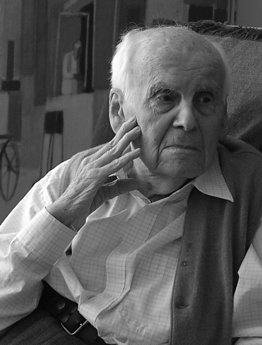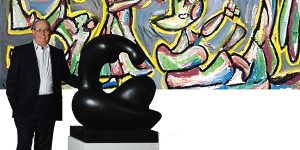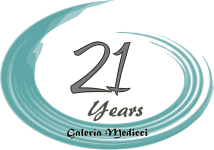Having the pleasure of visiting a new exhibition of Ivan Petrovszky allows us to appreciate once again the quality of a work always consistent. A year ago at this same gallery, he exhibited many of his recent works titled Ivan Petrovszky -Time traveler. In those works it was evident his condition of artist-traveler and the sample turned out to be largely a reinterpretation of past experiences and situations which accounted for his intense plastic activity.
Petrovszky should be said again, takes images directly from the street, "notes them down" quickly and then he processes them in an analytical and disciplined way in his workshop. Then, he makes "variations on the same theme" that result from those sketched images reworked under different formal and technical points of view. We find the same men working, sleeping, reading or playing chess in a variety of plastic perspectives, likewise, some expectant mothers or those characters that enjoy a conversation, of a moment of rest or simply sun bathing.
The spontaneity of the note remains in the works in his workshop. They do not lose expressiveness, but on the contrary, they emphasize their beautiful work status while technically rigorous. Petrovszky studies color and shape in different ways, the structure and the volume, the texture and the transparency, among other elements of expression. He uses the same reasons, and yet each piece is unique. "In my work there is no imagination, but transformation," said the artist, which is partly just because a fact is transformed into a memorable work. However, imagination is evident in the pictorial richness itself: as creation is through the language of painting.
These considerations are valid for the exhibition now at hand. The exhibition consists of works on paper which selection is due to a wide criterion of heterogeneity in terms of themes, techniques and various formats. Also at different implementation periods, with a predominance of the most current.
The public can observe the reinterpretations produced by the transformations on the same pictorial motif. Transformations that result from decisions made by the artist in terms of techniques used and depth analysis he makes to shape and color. The result is more pictorial or drawing works, according to the use of oil or water-based paints.
This deepening leads to greater austerity, condensation and synthesis of form and the volume, for which is fundamental to consider the treatment given to color. The latter has a leading role in plastic development of the artist, who has not exactly stood out for "prolifically" managing color. On the contrary, what he has done on his production is to enrich the shades of a color. Petrovszky defines itself as an artist "oligo chromatic", a word derived from Greek meaning "with little chromatics 'and believes that the creative process done with few colors allows him to proceed with greater depth and capacity of synthesis. Thus, the color planes silhouette forms without details. Being flatter, they lose definition, and the image remains resonating in our perception as wrapped forms or made by a breath of color.
The analytical condition of each work does not alter the gracefulness that comes from them. There is an involving atmosphere, even in structural drawings as the ones in New York, for example. The fog, the sensitivity caused by its atmosphere, is expressed by means of subtle gradations of lights and shadows, interacting respectively with the solid and secure lines of the constructions and their progressive non-definition. In other drawings, the color is worked "symphonically" as the artist would say, polychromatic supplementing the analytical status of the work. In this sense, it could be concluded that the structural elements used by Petrovszky are closely related to the chromatic development of the work. Thus, the color planes establish important distinctions by the contrast of the directional lines or by the way they "cubic" the space in a composition.
Above all this, the drawing transparences significantly. Expressing himself in lines, in tone or color, he defines a landscape, a still life or the human being with their burden of loneliness. All the exhibited works confirm the conceptual clarity of what the drawing is for Master Ivan Petrovszky: the ultimate expression of his will to transcend the limits of figuration.
Caracas, Venezuela
Agosto del año 1999
Visiting a new exhibition of Ivan Petrovszky is a fitting tribute to the Hungarian-Venezuelan artist. There is no doubt that Ivan is tireless and always has something to show.
Medici Gallery has been proposed three years ago to expose systematically the work of this great artist.
Since his arrival in Venezuela in 1945, Ivan has been active in the life of the country plastic. He immediately made presentations and participated in events where he received the applause and critical acclaim. Since 1946 has won major awards: the Michelena, the Planchart, D 'Empaire, National Design Award, etc., And was even worthy for the second time just five years ago, the Grand Prize at Arturo Michelena.
All these applause receives an artist who has been consistent with his conception and interests plastics. In general their attitude is distant or outside groups and fashion trends. Ivan has worked in a lonely yet integrated into the cultural context in which we live. Participates in exhibitions with young artists not inhibited by its position consecration or generation gap. His relationship with art is that of a painter who takes his craft, basing his work on the ongoing investigation of plastic and expressive means which are the hallmark of his work over the years.
The representation of a subject or scene on the street is for more than Ivan the entry of an anecdote. It is the bridge that allows you to talk about the problems plastic. The issue is just a vehicle, scaffolding, as he himself describes it, to inquire into the facts that he is interested. Therefore, the themes are repeated and often are the same.
However, this resource allows you to work in greater depth. Ivan currently works primarily with aqueous techniques on paper and in the intimacy that these means will allow, has come to explore its richness of color. Inquiring into the complementary, achieves "color theme songs" which combinations were, until recently, rare in his artistic production.
The space is conceived in terms of man. It is, as the artist says ... "of a space homocentric: from man to man, only being able to measure." It is then their compositional instrument par excellence and immediate reference to channel the proportions of the image created. It is also, somehow, the rationale of his loneliness. Based on this principle, you can build sets, men working, sleeping, reading, playing chess mothers or people simply enjoying a sun bath. All are captured by the analytical gaze of the painter: ... "I recognize that there is constructive. Mine is a sculptor who has never expressed but in drawing and painting. "
This rational approach to the artistic creation allows you to "manipulate" the angles and points of view of his characters. With this "manipulation" seeks the expressiveness of the forms is what ultimately gives sensitivity and beauty to the work, essential to artistic status. Similar qualities are achieved through the atmosphere created by the charcoal, the resulting texture of the letters printed newspaper or the delicacy of the line using the pen. The expressiveness of the line is often combined with the tonal richness of the stain. With these resources is sought spontaneity, synthesis, transparency, mobility and harmony in a drawing.
In the painting operates differently, as the oil allows you to design figures and urban landscapes with color drawings with a more constructive approach. Whatever means, drawing or painting, "the essence of the work of Ivan is the domain of sensitive technology, making it beyond the manual virtuosity alone.
In addition, Ivan is an artist who knows when to conclude the development of a work. He does not like the details and excesses, while recognizing that the design must be impulsive. That balanced approach, dominates the art. To dominate the picture is spontaneous and expressive.
"The technique," says the artist can be over emotional vicissitudes. Only in this way is how you can move to different sizes, formats, change the materials and support media. "It's having the domain of expressive means in hand to build in every way and his city-universe versions.
Caracas, Venezuela
September 2000
How many times will we see this work again? How many times will the author insist on the same characters, on a subject as definitely human as the one that observes him?
Drawing, especially work on paper, is closely linked to the expression of Ivan Petrovszky. Drawing on all types of paper including newspapers, and all the classical resources, pencil, ink, paints, watercolors, and pasta used to define bodies, most of the time in an urban setting. The square, the street, the public gardens are the places where occur the situations of this work, which relates its European accent: there, where everything seems to pass at a distance, where one can spend hours reading the newspaper, where the body movements lack emergency, and nevertheless, where their mere presence fills the image with expectation.
The models of this work have a certain age, and perhaps some children in their arms. All the time is for the neighborhood meeting. Consequently, its final thought is about the destiny of man.
Abound those who sleep, that rest, that let the time pass, indifferent. The lines of the bodies are few, precise and ungainly, lines of ink or pencil, sometimes semi-hidden by the color. The color finally reaffirms a climate between melancholy and existential. They are pure stripes, without accidents, without anecdotes, without details, but with an accent on the emotional that is capable of transmitting color. All these individuals, however, are showing their willingness to read-newspapers, letters-that is, they want to communicate or expect something.
I've always imagined Petrovszky work within the major themes of modern culture such as waiting and melancholy.
The guns did not cease after 1945. Quite the contrary, the upheavals have been continuous. For a man of this century, migrant by force of circumstances, which has seen disappeared nations and factions emerge, the solitary figure on a square or those beings standing at the line of the infinite sea, reveals the condition of the time.
But this is a work without rhetoric. What I say has no more sense than the position of a thought, of a creator in the context of the contemporary debate of ideas and images. Petrovszky's work refers to the vision of man and therefore, many times, it reminds me of a concept of Michel Seuphor (1965) referred to the transformation "through the force that gives rise to calm, through calm that dominates situations.
Thus, tranquility is the only victory. And the permanence of the victory gives the style." In this work the body alludes to human dispositions.
Petrovszky's characters are sitting down, lying, standing up and usually alone even though they appear next to each other. The exception is those who are on the beach, the couples either dating or in family groups. His subject is one and even covers the model in the workshop (a few times naked) and stray dogs.
Repeatedly it is a work that represents man, whether in a resting or working attitude. The background is constituted by one tone to perhaps two, in horizontal stripes. That color goes through the body of the individuals; hence, shape and color have a single ring. But the models may show a different register in the background. Then the figure is seen built by the touch or geometry of color that defines it in the chromatic space. His palette has mainly blues, reds and gray, but we will also find yellows, browns and some greens. Sometimes it has texture and sometimes transparencies.
All of this has brought the artist the nickname of solitary. Indeed, Petrovszky has been removed from fraternities or clubs that made history, he has been out of the social hand-kissing, and he spends his time only in his studio and on certain streets of Caracas (because it is about Caracas) where he takes his notes from live models, whom he then takes to his works both on paper as to his painting.
Petrovszky is a "Time Traveler" because throughout his life he has gone from one city to another city, from one continent to another. In this exhibition there are some landscapes or impressions of cities, ports, streets, always with that look, that color, which gives a general tone. In addition, his column in a Venezuelan newspaper was entitled "Travel Folders", so the fact of traveling is to move, go on a pilgrimage has been a constant in his life. In his drawings, watercolors and inks the theme of the reader is common, which can be taken as a metaphor of the journey.
This exhibition, "" Time Traveler "is a journey through the folders, papers, the file of the" Master" as well as among some of his recent works. It is once again meeting with the image of man and his dreams before the skyline.
Caracas, Venezuela
March 1998

Born in Egkey, Hungary on March 9, 1913. He died in Caracas on April 2007.
Academic and Artistic Activities
Studies High school and university in Budapest, Hungary. His first painting studies are performed in Professor István Szonyi Academy.
He teaches painting and drawing at the School of Visual Arts "Cristóbal Rojas"
Solo Exhibits
1945 - Ateneo of Caracas, Caracas
1946 - Ateneo of Valencia, Valencia
1947 - Museum of Fine Arts, Caracas
1953 – Estilo Gallery , Madrid, Spain
1957 - Center of Fine Arts, Maracaibo
1958 - Gallery of Contemporary Art, Caracas
1959 – Museum of Fine Arts, Caracas
1962 - Ateneo of Valencia, Valencia
1962 – Mendoza Hall, Caracas
1965 – Mendoza Hall, Caracas
1965 - Universidad Central de Venezuela, Caracas
1966 - Marcos Castillo Gallery, Caracas
1969 - Inter-American Development Bank, Washington, DC, USA
1971 - BANAP Gallery, Caracas
1972 – Mendoza Hall, Caracas
1976 – Museum of Fine Arts, Caracas
1984 – Museum of Fine Arts, Caracas
1988 – Mendoza Hall, Caracas
1992 - Gala Art Gallery, Valencia
1993 - Center of Fine Arts, Maracaibo
1998 - Medicci Gallery, Caracas
1999 - Medicci Gallery, Caracas
2000 - Universidad de Carabobo, Valencia
2000 - Medicci Gallery, Caracas
Awards and Recognition
1936 - Honorable Mention "Sznnyei Merse" Budapest, Hungary
1941 - Rome Prize, Budapest, Hungary
1958 - Federico Brandt Award, Caracas
1958 - First Prize D'Empaire, Maracaibo
1958 - Grand First Prize "Arturo Michelena", Valencia
1959 - National Design Award and Engraving, Caracas
1960 - Gold Medal, National Photography Exhibition, Caracas
1961 - First Prize in Black and White, National Exhibition of Photography, Caracas, Venezuela
1961 - Antonio Edmundo Monsanto Award, Barquisimeto
1962 - Prize City, Valencia
1963 - Prize "John Boulton, Caracas
1964 - Prize Drawing, Maracay
1982 - Prize Drawing CONAC, Caracas
1985 - Award Armando Reveron, Living "Arturo Michelena" Valencia
1988 - First Prize Drawing 1 National Biennial of Fine Arts, Caracas
1988 - Prize Drawing Arts Western Hall, Barcelona
1990 - Award Armando Reveron, Living "Arturo Michelena", Valencia
1991 - Prize Drawing CONAC, Caracas
1992 - The Exhibition "Arturo Michelena" creates and grants Ivan Petrovszky First Prize for Drawing
1992 - The 6th National Drawing Exhibition pays tribute to Ivan Petrovszky with a room devoted entirely to his drawings
1995 - Grand First Prize "Arturo Michelena", Valencia
Represented by
National Art Gallery, Caracas
Museum of Fine Arts, Caracas
Museum of Contemporary Art of Caracas Sofia Imber, Caracas, Venezuela
Museum of Modern Art, Paris, France
Museum of Modern Art, Bogotá, Colombia
Irving Stone Collection, New York, USA
Medicci Gallery, Caracas, Venezuela
Presidential Residence of the Republic of Venezuela - La Casona, Caracas IVIC, Caracas

Interview with Mr. Tomás Kepets, director of the Medicci Gallery
Read more
"During those two decades, Galeria Medicci advanced into a river of creations and continues to show the majors artists, the vanguard of every moment, lucidity and everything that bridges with spiritual values. The experiences accumulated in more than two decades have sharpened the dynamics of today ". José Pulido
Works of renowned artists in the United States, the Caribbean and Latin America such as Manuel Mendive, Carlos Luna and the American sculptor Manuel Carbonell, as well as Venezuelan expats based in Paris, France, Annette Turrillo and Karim Borjas.